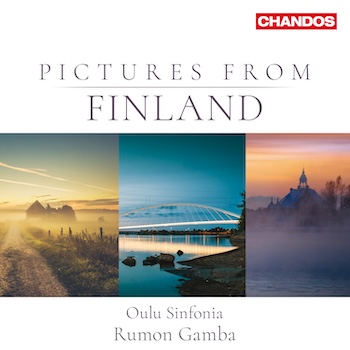By Jonathan Blumhofer
Though Sibelius’s music has come to define whatever Finnish music is supposed to sound like, he certainly wasn’t the country’s only active, turn-of-the-20th-century composer.
 What is 20th-century Finnish orchestral music without Sibelius? That’s not the day’s most pressing question—or, necessarily, this recording’s main point, though the conundrum hovers over Pictures of Finland, the Oulu Sinfonia’s new recording with conductor Rumon Gamba.
What is 20th-century Finnish orchestral music without Sibelius? That’s not the day’s most pressing question—or, necessarily, this recording’s main point, though the conundrum hovers over Pictures of Finland, the Oulu Sinfonia’s new recording with conductor Rumon Gamba.
Though Sibelius’s music has come to define whatever Finnish music is supposed to sound like, he certainly wasn’t the country’s only active, turn-of-the-20th-century composer. There was, for instance, Selim Palmgren, whose eponymous four-movement suite gives the album its title.
Pictures depicts four seasonal themes: springtime dreams, a rustic minuet, falling leaves, and a sleigh ride. For those banal scenarios the composer has supplied commensurately forgettable music, stuff that mostly relies on repetition and bombast at the expense of musical depth and smooth transitions. Still, the score has its moments: the added-sixth chord that “Dreams in Spring” ends on is a nice surprise. “Sleigh Ride” is rich and lively, the sort of thing Rimsky-Korsakov might have spun out. Throughout, Palmgren’s instrumentation is idiomatic and thoughtful.
Leevi Madetoja, on the other hand, brought a somewhat fresher outlook to his Suite pastorale and Marian murhe.
The former is an orchestration of a four-movement piano suite that sounds a bit like something Ravel and Grieg might have written together over a pot of coffee. Its opening movement is unpretentiously tuneful and dreamy—not to mention vividly scored. So is the lithe “Caprice” and lilting “Legenda.” If the closing “Waltz” sounds more like a dance in search of a tune than anything else, at least it’s got plenty of rhythmic zip.
Marian murhe is of a completely different character: rich, devotional, and with a lively fugal section in the middle. If anything, Madetoja’s writing calls to mind—though in a more melodically and harmonically mobile way—Arvo Pärt, who was twelve when the composer died in 1947.
By that time, Väinö Raitio was two years in his own grave. The most obscure of this album’s five composers (both at home and abroad), his Scherzo ‘Felis domestica’ makes a concerted effort to have fun, though either by dint of the disc’s engineering or the Sinfonia’s performance, the music comes off like a fairly stiff, slow-motion cartoon. More impressive is the Idyll, whose shapely lyricism and bold apotheosis are well-etched.
Equally striking is Robert Kajanus’s Suomalainen Rhapsody No. 2. The second of the composer’s Finnish rhapsodies, it paved the way for pieces like Finlandia, charting a nationalistic course for the generation that followed. Though the Rhapsody seems to take some measure of structural inspiration from Smetana’s Ma vlast, its musical content is varied and compelling.
So, in its way, is Kajanus’s Adagietto, another work of his that suggests music-to-come by Sibelius. In this case the piece in question is the Andante Festivo, though Kajanus’s opus lacks the latter’s enchanting lyricism and inevitable progressions.
But Sibelius wasn’t just a tunesmith, as his brief cameo on the disc reminds: “Kurkikohtaus”—the “Scene with Cranes” from his incidental music to Kuolema—sounds, especially in this context, like something from another planet. Spare, chilly, shimmering, evincing an enormous sense of physical space with a minimum of gestures, one can come away from hearing it with a renewed appreciation for the singularity of the composer’s voice.
Here as elsewhere on the recording, Gamba leads the Sinfonia with a sure hand and there’s often a missional zeal that accompanies the group’s performances. The album’s engineering, however, is a bit haphazard: the solo violin in “Kurkikohtaus” sounds distant and parts of Pictures from Finland come off as more leaden than the ensemble’s energetic playing suggests they should. Nevertheless, the larger effort shines a welcome light on a corner of classical music that’s often neglected and has been overshadowed, of late, by the giants of late-20th– and early-21st-century Finnish composition.
Jonathan Blumhofer is a composer and violist who has been active in the greater Boston area since 2004. His music has received numerous awards and been performed by various ensembles, including the American Composers Orchestra, Kiev Philharmonic, Camerata Chicago, Xanthos Ensemble, and Juventas New Music Group. Since receiving his doctorate from Boston University in 2010, Jon has taught at Clark University, Worcester Polytechnic Institute, and online for the University of Phoenix, in addition to writing music criticism for the Worcester Telegram & Gazette.







